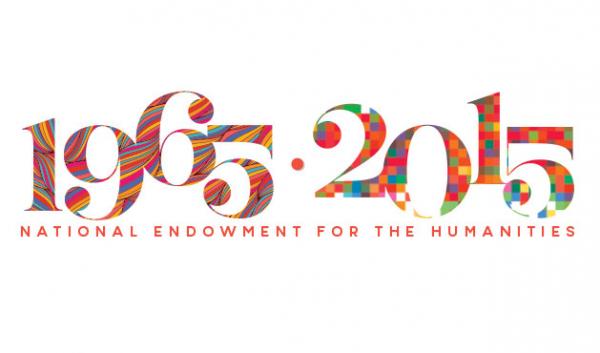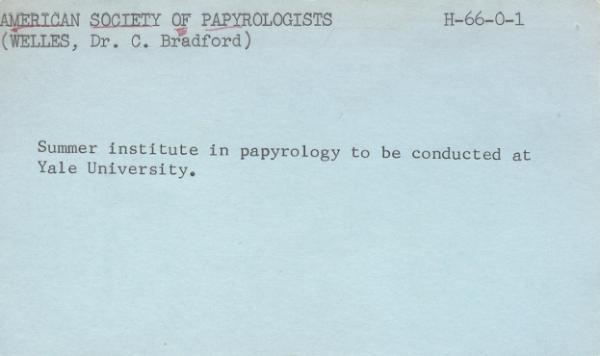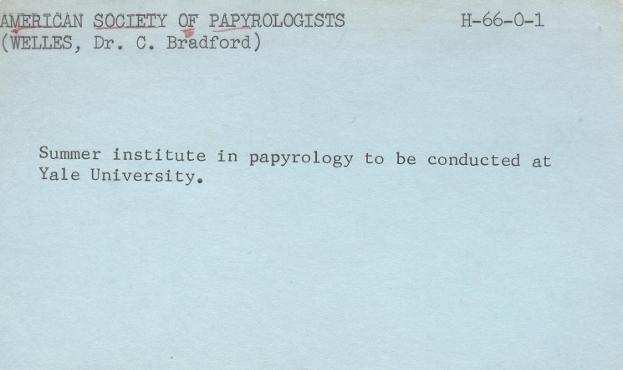NEH Turns 50
The National Endowment for the Humanities kicks off year-long celebration of the agency’s 50th anniversary

50 years of the National Endowment for the Humanities (NEH)

50 years of the National Endowment for the Humanities (NEH)
The National Endowment for the Humanities (NEH) this week will kick off a year-long celebration of the agency’s 50thanniversary.
Fifty years ago, on September 29, President Lyndon B. Johnson signed into law the National Foundation on the Arts and the Humanities Act of 1965 at a White House Rose Garden ceremony, attended by scholars, artists, educators, political leaders, and other luminaries. (Read a history of how NEH got its start ).
The law created the National Endowment for the Humanities as an independent federal agency, the first grand public investment in American culture. It identified the need for a national cultural agency that would preserve America’s rich history and cultural heritage, and encourage and support scholarship and innovation in history, archeology, philosophy, literature, and other humanities disciplines.
In the five decades since, NEH has made more than 63,000 grants totaling $5.3 billion, including leveraging an additional $2.5 billion in matching grants to bring the best humanities research, public programs, education, and preservation projects to the American people. Examples of NEH impact include funding that has led to the discovery of a lost Jamestown settlement fort, brought the scholarship of famed linguist Deborah Tannen to a broader audience, created the first museum exhibit of the now cultural icon King Tut, preserved the papers of ten presidents including George Washington and Abraham Lincoln, invested in the career of then relatively unknown documentary filmmaker Ken Burns, and thousands of other examples.
“For the past 50 years the National Endowment for the Humanities has helped create and sustain the nation’s cultural capital,” said NEH Chairman William Adams. “NEH grants have enabled libraries and museums to preserve and develop their collections. NEH grants have allowed historic sites to broaden their public programs. Our grants have funded exhibitions across the country that give Americans access to history and culture in their towns and cities. Our grants have sparked additional investment that has expanded the ability of cultural organizations to serve the public. The immense growth in this cultural infrastructure would not have been possible without NEH leadership and public investment in the humanities to support America’s cultural legacy.” (Read reflections from Chairman William Adams on NEH’s 50th anniversary.)
Below are highlights of NEH’s 50th anniversary celebrations:
- Wish NEH Happy Birthday on September 29 with #NEHturns50— NEH will hold a virtual birthday party on September 29 at 1p.m. and invites members of the public, grantees, partnering organizations, other federal agencies, and friends of the agency to share why the love the humanities using our template on Twitter, Facebook and other platforms using the hashtag #NEHturns50. See this toolkit on how to participate and to sign up.
- 50 for the 50th website –A special web feature at 50.neh.gov highlights the top grant projects from NEH’s history. Learn about the role NEH grants have played in:
- underwriting the collection and editing of the papers of George Washington and other Founders
- changing our understanding of the Trans-Atlantic slave trade
- deciphering an ancient Incan language written entirely in knots
- the re-discovery of a the original Jamestown colony fort
- the preservation, publication, and interpretation of the Dead Sea Scrolls
- the creation of the field of digital humanities
- crowdsourcing transcriptions of historic menus at the New York Public Library
- 50 years of grant-making online – NEH has spent more than two years digitizing its earliest grant records—which were recorded on paper punch cards called “McBee cards”—in order to capture the entire 50-year history of the agency’s grants in a searchable online database. Through NEH’s Funded Projects Query Form, users can now find records for every NEH grant, dating from the very first grant, issued in 1966 to the American Society of Papyrologists to conduct a summer institute at Yale University. The data is also available for bulk download on NEH’s Open Government webpage as part of the White House’s Open Government Initiative.
Items of interest include:- NEH’s first digital humanities grant, in 1967, for an EDUCOM conference at the University of Pittsburgh
- grants to On the Waterfront screenwriter Budd Schulberg for the Watts Writers’ Workshop
- a 1969 Education grant to Altona Johns and composer Undine Smith Moore for a course on “The Black Man in American Music”
- a 1973 fellowship to Harold Bloom for research relating to his acclaimed work, The Anxiety of Influence
- a 1973 fellowship to Elie Wiesel for a history of a typical East European Jewish community pre-WWII
- a 1974 grant for the Thesaurus Linguae Graecae, one of the first digital educational resources
- the 1976 grant that brought the blockbuster “Treasures of Tutankhamun” exhibit to six American cities
- a 1976 media grant to Marlon Brando and James Beck for a project on “The First Americans”
- a 1978 fellowship that allowed Noam Chomsky to refine and expand his theories of universal grammar
- Year-long special events --- Throughout the year-long anniversary, NEH will be partnering with other humanities institutions for events celebrating the agency’s 50-year history of supporting the humanities
Happening soon:- September 30—Aspen Institute roundtable discussion, NEH Chairman William Adams speaks with Washington Post critic Philip Kennicott about NEH’s history and future
- October 14—“In Performance at the White House” – recording of a special White House concert celebrating the 50th anniversaries of NEH & NEA, to be broadcast on PBS by WETA
- October 31— Chicago Humanities Festival, with Chairman Adams in conversation with poet Claudia Rankine
(See this PDF for more 50th events)
- New issue of Humanities magazine – A commemorative 50th anniversary issue of NEH’s bimonthly magazine Humanities features articles about landmark NEH grant-funded projects, including:
Hashtag: #NEHturns50

